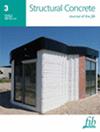A review of punching behavior of slab–column connections with recycled coarse aggregate concrete
IF 3.3
3区 工程技术
Q2 CONSTRUCTION & BUILDING TECHNOLOGY
引用次数: 0
Abstract
This paper presents a state‐of‐art regarding the punching of flat slabs made with coarse recycled concrete aggregate concrete (CRCAC). Punching shear is a phenomenon that occurs in reinforced concrete slabs when concentrated loads are applied near a column or other support. It refers to the failure mechanism where the concrete reaches shear failure at a critical section around the column. CRCAC is a structural material that conforms with circular economy concepts, but its design for punching using current formulae may be unsafe due to the lower strength of the concrete that can be caused by the shape or the surface cleanness of the recycled aggregates when compared with the natural ones. The results highlight the need for further research on this area, since the available experimental results are few and mainly from tests with thin slab specimens. Since the punching phenomenon is dependent on the scale effect, it is mandatory to have more results for slabs with representative thickness. The applicability of the models for punching resistance in EC2, ACI318‐19, and the upcoming second generation of EC2 was also investigated. These codes can produce safe estimates for CRCAC slabs. However, it was found that the second generation of EC2 is less conservative than the other models.使用再生粗骨料混凝土的板柱连接冲孔行为综述
本文介绍了使用粗再生混凝土骨料混凝土(CRCAC)制作的平板的冲剪现状。冲剪是钢筋混凝土板在靠近柱子或其他支撑物施加集中荷载时出现的一种现象。它指的是混凝土在柱子周围的临界截面达到剪切破坏的破坏机制。CRCAC 是一种符合循环经济理念的结构材料,但与天然骨料相比,由于再生骨料的形状或表面清洁度可能导致混凝土强度较低,因此使用现有公式进行冲孔设计可能不安全。由于现有的实验结果很少,而且主要来自薄板试样的测试,因此这些结果突出表明有必要在这一领域开展进一步的研究。由于冲孔现象取决于尺度效应,因此必须获得更多具有代表性厚度板块的结果。此外,还研究了 EC2、ACI318-19 和即将推出的第二代 EC2 中抗冲孔模型的适用性。这些规范可对 CRCAC 板进行安全估算。但研究发现,第二代 EC2 的保守程度低于其他模型。
本文章由计算机程序翻译,如有差异,请以英文原文为准。
求助全文
约1分钟内获得全文
求助全文
来源期刊

Structural Concrete
CONSTRUCTION & BUILDING TECHNOLOGY-ENGINEERING, CIVIL
CiteScore
5.60
自引率
15.60%
发文量
284
审稿时长
3 months
期刊介绍:
Structural Concrete, the official journal of the fib, provides conceptual and procedural guidance in the field of concrete construction, and features peer-reviewed papers, keynote research and industry news covering all aspects of the design, construction, performance in service and demolition of concrete structures.
Main topics:
design, construction, performance in service, conservation (assessment, maintenance, strengthening) and demolition of concrete structures
research about the behaviour of concrete structures
development of design methods
fib Model Code
sustainability of concrete structures.
 求助内容:
求助内容: 应助结果提醒方式:
应助结果提醒方式:


